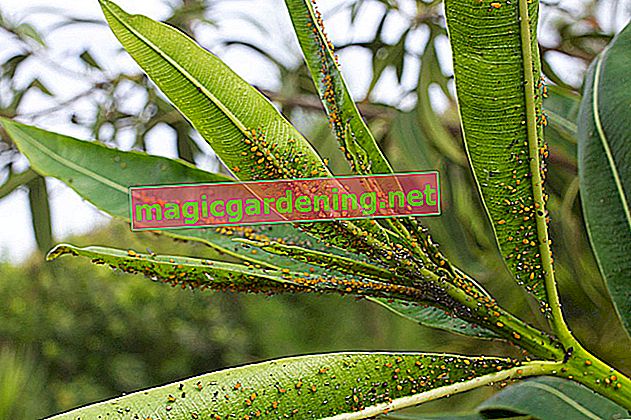
Recognize and treat fungal infections - this is how it works
Persistent fungal infections are common among orchids. Regardless of the current pathogen, the disease manifests itself as a white coating as a result of powdery mildew or as brown-black spots as a result of the leaf spot disease on the previously lush green leaves. If the infestation is limited to the foliage without the shoots, bulbs or aerial roots being affected, you are fighting the fungal disease with natural means. That is how it goes:
- Quarantine the infected orchid to prevent further spread
- Cut off the infected leaves with a disinfected scalpel and throw them in the household waste
- For brown leaf spots, mix lime-free water and cinnamon into a paste and brush the plant with it
- If the topping is white, add 125 ml of fresh milk to 1,000 ml of soft water and spray on every 2 days
also read
- Common diseases in cacti - tips on symptoms and control
- Common Corkscrew Willow Pests - Tips on Symptoms and Control
- Common Sycamore Diseases - Tips for Combating
Ecologically minded orchid gardeners also treat these diseases with garlic stock. To do this, bring 500 ml of water to the boil and pour 4-5 crushed garlic cloves over it. After half a day, strain the liquid and spray the infected orchid with the brew every 2 days.
Bacterial diseases target soft-leaved orchids
If sharply demarcated black spots without a light border appear on orchid leaves, you are dealing with a life-threatening bacterial disease. As the spots expand, the remaining tissue becomes slimy-moist and the foliage dies. The popular Phalaenopsis in particular are prone to infestation due to their soft leaves. How to take action against orchid disease:
- Immediately isolate the diseased orchid from other plants
- Cut off the affected leaves with a disinfected scalpel
- Dust the cuts with cinnamon or charcoal ash
In the quarantine room, the orchid is no longer sprayed and watered more sparingly. If the plant has a stable constitution thanks to proper care, it will fight off the bacteria and recover. Effective treatment methods are so far not available, so that weakened orchids are hopelessly lost. Hope has been growing for some time, as fungicides based on difenoconazole have proven to be helpful in practice.
Falling flowers is not always a symptom of the disease
If the foliage is affected by a disease, sooner or later the supply of the flowers will come to a standstill and they will fall off. Successful control of the disease on the leaves also stops the fall of flowers. If, however, the flowers fall off despite healthy leaves, the shortcoming is due to an omission in the maintenance protocol. To get to the bottom of the cause, carefully examine the site conditions:
- Cold draft over a long period of time causes the flowers to fall off
- Continuously warm heating air from below damages buds and flowers
- If there is a lack of light, the orchid sheds its flowers
Do not place a fruit basket with ripening apples, pears or similar fruits near your orchids. The outflowing ripening gas ethylene causes the flowers to wilt prematurely.
Lice have soot in their luggage
Lice of all kinds act as biting and sucking pests. During their shameful activity, aphids, scale insects and the like excrete honeydew. This sugary excretion forms an ideal breeding ground for sooty mildew. It is a widespread black fungus that begins to spread on the underside of the leaves. The resulting black spots hinder vital photosynthesis. Fighting the lice also cures the disease. That is how it goes:
- Shower the lice infested orchid with the hardest possible water jet
- Then wipe the leaves on the top and bottom with vinegar water
- Alternatively, make a spray solution from 1 l of water and 15 ml of pure soft soap (€ 17.27 at Amazon *) and use it every 2 days
Stay on the lice's heels until there are no more pests cavorting on the leaves. If you are dealing with hardened lid scale insects, they are immune to the classic soap solution. In this case, you will not be spared from dabbing the lice one by one with a cotton swab soaked in alcohol. Most orchids respond to large-scale spraying with alcohol-containing solutions by shedding their leaves.
Tips
One of the main pillars in the care of orchids is the use of lime-free water. Collected and filtered rainwater, as the noble flowers from the tropical rainforest are used to, is ideal. Where there is no space for a rain barrel, resourceful hobby gardeners use this trick: 1 liter of peat is poured into a cotton sack and hung in a large watering can. Within 3 days, the peat removed most of the lime from the water.








